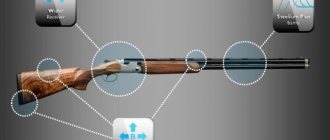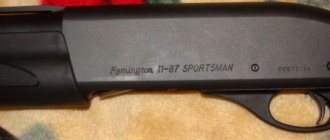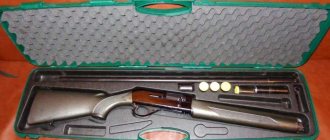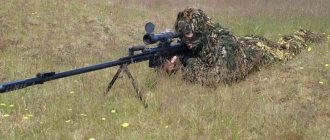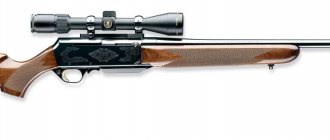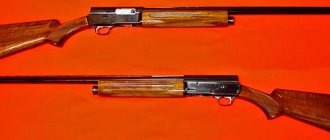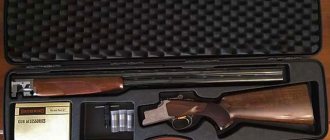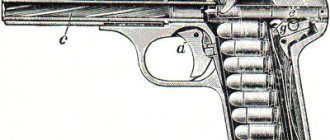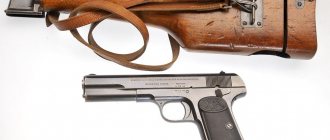Description
Browning Gold Fusion is a self-loading shotgun with a gas-operated reloading system. The company's status in the global market speaks for itself and the Gold line models look impressive. The stock and fore-end are made of valuable chocolate-colored wood (walnut) with a non-slip coating. Between them is a black aluminum block with the company designation “Gold Fusion”.
Roughly speaking, the Browning legend is universal in all respects. The weapon became a breakthrough for the period 1995-2000, because it was adapted for all types of cartridges. The barrel is adjusted to different types of game using insert chokes - this was a novelty for that time.
Browning Gold Light Mossy Oak Break Up
Technically, Browning Gold also took a step forward. The manufacturer has reduced the weight of the model by switching to lightweight material. There are also changes in the reloading system: the company's proprietary developments were used - automatic with a cylindrical compensator that pushes the bolt before reloading. Its purpose is to reduce wear and speed up reloading when firing high-power loads.
It should be noted the sharpening of the butt and fore-end. The emphasis is on the traditional way of shooting for right-handers, so that the weapon does not slip out and does not rub against clothing. The trigger is made in a pistol style. According to reviews, the descent into Browning Gold is difficult but smooth. Hunting does not require additional skills or stress from the shooter.
The Browning Fusion is suitable for shooting waterfowl (with the appropriate equipment), but is officially intended for hunting wild birds. The feature of the gun is reliability. When in good condition, shooting is not affected by air temperature, rain, snow, dust, dirt, sand, etc. Even direct mechanical contamination of the automation does not lead to a worsening of the fire.
Browning Gold Evolve Sporting
Interesting facts about the Ithaca 37 shotgun
Let's tell you some interesting facts about the Ithaca M-37 shotgun:
- Due to the fact that the extraction of spent cartridges occurs through a window at the bottom of the receiver, the Ithaca M-37 series shotguns are equally convenient for both right-handed and left-handed people.
- Ithaca M-37 series shotguns have repeatedly appeared on television screens in American films. A wide variety of characters shoot from these weapons: both positive and not so good, in films of almost all genres - from comedies and action films to dramas and thrillers. The Ithaca M-37 Stakeout shotgun even flew into space and fought with evil xenomorphic aliens (the movie Aliens), with the words: “Eat this!” - a Marine from the space landing shoots the “alien” in the head and closes the hatch of the armored personnel carrier.
- This shotgun was also used in computer games, including Far Cry 2, Resident Evil 5, Medal of Honor: Underground, Metal Gear Solid: Portable Ops, Grand Theft Auto IV and many others.
The main rule of the Ithaca company is quality and reliability. Although the development of John Moses Browning is more than a hundred years old, the Ithaca 37 pump-action weapon is still very popular today. High reliability, good combat, ease of use - all this makes it in demand both for self-defense and hunting.
Operating principle
The principle of the reloading mechanism is standard for hunting life. Browning Gold is a modified version of a regular gas operated gun. It works according to the same laws as everyone else, but faster, more reliable and more powerful.
How Browning Gold works:
- At the moment the hook is released and the projectile is released, gases under high pressure enter the hole in the barrel;
- They push out the piston;
- The piston pushes the wedge open and pushes the bolt out;
- The cartridge flies out, and the coil spring pushes a new one into the barrel.
The plastic cylinder on the bolt ensures safety and reduces wear when using high-power cartridges. At very high pressure, it opens a hole in the system and releases excess. This cylinder plays the role of a pusher and at the same time a part for releasing pressure.
Browning Gold Golden Clays Ladies Sporting Clays
The second feature that affects the action of Browning is the drilling of the barrel. This is a patented processing mechanism called Back Bore. Its essence lies in expanding the diameter of the barrel bore from the generally accepted 18.4 to 18.9 millimeters. The use of technology reduced the friction of shot and bullets at the moment of departure, which increased the accuracy and speed of the charge.
Design
Comparing the lines of this manufacturer, the differences are noticeable in the details. Almost all Browning models use proprietary technologies that increase the rate of fire, accuracy, and ease of shooting.
Browning Gold main modules:
- Aluminum block, which reduces the weight of the entire structure without sacrificing strength;
- Sighting bar with removable fiber optic front sights. Primary colors are green, red and yellow;
- Power Drive gas exhaust system. It is designed to reduce recoil and vibration during reloading. This also affects the accuracy of the fire;
- Extended Vector Pro barrel with Black Bore technology. It is equipped with a special constriction for quick chokes, which also reduces spread and increases the speed of bullets.
The price for this hunting rifle may be too high due to the predominance of proprietary modules and technologies. It focuses on reliability and durability. Even a neophyte hunter can cope with disassembly and cleaning.
The weapon's usability stands out separately. You need to get used to it, but the time to get used to it is minimal. The creators put a lot of effort into the fore-end and butt - they were specially adjusted to ensure an uninterrupted rate of reloading when shooting with sporting or hunting ammunition in different conditions.
Owner reviews of Browning Maxus
The main advantages of the Browning Maxus Standard semi-automatic hunting rifle are its legendary reliability and impeccable quality of fitting of parts. The shooting characteristics are also high: this gun has excellent accuracy and accuracy, with very soft and comfortable recoil.
The American semi-automatic is very good for hunting on foot over long distances, since its weight is approximately 3.2 kg
Among the disadvantages, it can be noted that, like other self-loading semi-automatic devices, it is very demanding in the choice of cartridges: if you load a homemade cartridge with either a metal sleeve or a 70 mm cartridge, the gun will definitely jam and it is impossible to eliminate this malfunction without disassembling the gun. Disassembling a loaded gun can turn into a tragedy, so you should only use factory-made ammunition with a 76mm plastic case. In addition, this American semi-automatic machine has a relatively high price, compared to, for example, Russian or Turkish models.
Advantages and disadvantages
This miracle of weaponry appeared on sale in the late 90s, and the main demand came in the 2000s. During this time of operation, the gun managed to prove itself as one of the most reliable. Over the years of use, Browning Gold has received positive reviews in 9 out of 10 cases.
Browning Gold FLD Stalker
What makes golden browning stand out today:
- Versatility. Changing choke constrictions in less than 1 minute is relevant at all times, and in Browning Gold this system is implemented perfectly;
- Don't be picky about charges. Even shooting with the Russian Taiga cartridge in this gun is smooth and smooth;
- Does not require a special care regimen. The shutter and trigger system are made simply and reliably. To clean them, even without disassembling it is enough to mechanically shake off the body and wash it with hot soapy water, and then apply 1-2 drops of gun lubricant;
- The weight of the weapon is not inferior to modern analogues. A sophisticated and simple block with a built-in tubular magazine and shank makes the design lighter by 20%-30% compared to analogues;
- The inner surface of Gold is chrome plated. This eliminates corrosion and prevents the appearance of soot. Even when it appears, it does not affect the performance of the modules and the firing characteristics.
Among the shortcomings, experienced hunters highlight the refined inner side of the butt. It is thin and not protected by a coating like other parts of the weapon. You can extend the service life yourself using linseed oil, smeared over the surface and heated over a fire. After drying for a day, a layer of beeswax dissolved in gasoline is applied to the oil layer.
Browning Gold Fusion
Important: During continuous shooting, problems with reloading are rarely noted. The point is the trigger - it must be completely released and smoothly brought to the shot. Then the rate of fire does not decrease, and the probability of a wedge is minimal.
The most notable disadvantage is the cost. Today, Browning Gold models are considered almost antique. Even 10 years ago, the price of a gun was in the high segment - but this was due to the reliability and name of the manufacturer, a leader in the market.
Browning BPS pump action shotguns
In 1977, despite the growing popularity of self-loading shotguns, the FN company, which by that time had become the owner of 90% of the shares of the Browning Arms Company, took the risk of implementing its plans using John Browning’s patents of 1913 and 1915. released the Browning BPS pump-action shotgun.
At the same time, the company was targeting primarily the European buyer, since there were already enough offers for pump-action shotguns on the US market.
Let's take a closer look at this particular model, since the original Remington 17 or Ithaca 37 are very rare.
The BPS model range produced by Browning includes dozens of options, differing in calibers, barrel length and drilling, types of muzzle devices, sights, magazine capacity, stock shape and material, receiver finish and other characteristics.
The gun is now available in three calibers: 10, 12 and 20; 10-gauge shotguns are manufactured with chambers 89 mm long, while 12- and 20-gauge shotguns are made with 76 mm chambers. The length of the barrels varies from 508 to 813 mm (in 2″ increments). The weight of the guns is quite significant - 4.2-4.3 kg in 10 gauge, 3.4-3.5 kg in 12 gauge, 20 -m - 3.1-3.2 kg.
The Hunting modification has the widest choice; other, more highly specialized modifications have one or two options. The high durability of the weapon is noted, characteristic of all Browning developments.
In hunting versions, it is not uncommon to fire up to 30 thousand rounds without repair. The gun is also characterized by excellent balance and posability, which, by the way, is one of the distinctive features of Browning’s designs.
The reason for this is that John himself and his brother Matthew were excellent shooters and actively took part in shooting competitions - naturally, with weapons of their own production. Even in his old age, several years before his death, John could break 96-98 out of 100 plates on a trench stand. It is clear that all samples were tested and finished in person. Contemporaries mention that John, lost in thought, went out to the prairies in his state of Utah and fired a pistol at a small stone with a bullet to move and roll, and then hit it, rolling, with everyone else, until the magazine was empty.
In this activity he achieved phenomenal success. As he himself said, such entertainment helped him think. By the way, the pistol he fired from was a prototype of the famous Browning FN 1900.
Browning BPS shotguns today have two bore options. In the first case, the diameter of the cylindrical part of the barrel is 18.5 mm, and screw-in injector-type nozzles are used as replaceable choke constrictions.
In the second case, the diameter of the bore is increased to 18.8-18.9 mm. This drilling option is called Backbore; The screw-in choke tubes here use their own, which are different from the injector tubes and are not interchangeable with them.
The Backbore, according to the manufacturer, is the most suitable for magnum shotgun ammunition, as it optimizes the characteristics of the movement of the shot through the bore - which, in turn, improves the action of the gun - and also reduces the feeling of recoil. In each caliber, the gun can be equipped with different barrels, which are installed without any additional adjustment.
Barrel nozzles, when converted to metric units, have narrowings: 0.10, 0.26, 0.46, 0.65 and 0.75 mm; there is another one with a diameter slightly wider than the bore, providing combat with a wide scree, as in the case of using a “cylinder” choke.
There is also an extended “extra-choke” nozzle with a narrowing of 0.96 mm, protruding 19 mm beyond the overall dimensions of the barrel. On the protruding part of this nozzle there are gas discharge holes; According to the manufacturer, this solution minimizes the negative impact of the exhaust of powder gases when shooting with small shot (however, experience shows that this method usually works when these gas release holes are located away from the muzzle). Additionally, there is a “paradox” rifled attachment, which protrudes 90 mm beyond the muzzle of the barrel and has six left-hand grooves 0.27 mm deep with a pitch of 48 calibers.
Browning BPS device
The receiver of the BPS shotgun is steel, with one lower window, modern in shape, simple and quite technologically advanced to manufacture. This design is more protected from clogging in our hunting conditions, especially forest ones, and, if necessary, makes it easier to select cartridges, since they fall right under your feet.
For the information of our hunters: in England, Germany and many other European countries, a plastic sleeve is considered environmentally harmful, since, unlike paper, it is not recycled by nature.
Conscious and pedantic hunters take such cartridges away from hunting areas, so guns with ejectors are not popular in the hunting version. Another thing is sports, where ejectors are ubiquitous.
A dovetail strip can be milled on top of the box for installing collimator or optical sights. The receiver itself houses the bolt frame, bolt, trigger mechanism, feeder, cut-off stop and fuse.
One of the differences between the BPS and its predecessor, the Remington 17 shotgun, is the safety, which is located in a place familiar to a European hunter with a double-barreled shotgun - on the neck of the butt, actually on the back of the receiver.
The forend, which operates the gun mechanism, has two rods that move in longitudinal grooves on the inner side walls of the receiver. A cartridge cutter and a shutter stop are installed in their grooves on these walls. In the front part of the receiver there is a thread for installing a tubular magazine, and there is also a mounting hole for the breech of the barrel. At the end end of the rear part of the box there is a threaded hole for connecting the buttstock.
The trigger-type trigger, with a disconnector, is assembled together with the bolt stop lever on a single base, which is compressed after the cross pin is pushed out. Another pin holds the most original part of the gun - the feeder. This pin is located across the gun in the upper rear part of the box and serves as an axis for rotating the feeder to the desired angle.
The feeder has the form of a spring fork with long front ends, which serve to eject the spent cartridge case and feed a new cartridge, and short rear ends with a copying surface in contact with the bolt frame, which, in turn, is connected to the forend rods.
The muscular effort of the shooter when moving the forend forward with the help of rods is transferred to the bolt frame; in this case, the bolt itself, mounted on the frame, enters the space inside the feeder fork and, once in the extreme forward position, locks the barrel using a vertically sliding wedge.
A wide ejector tooth is mounted at the bottom of the shutter mirror, which removes the cartridge case (or European type, unused cartridge) from the chamber. The reflection of the cartridge case (cartridge) occurs under the action of the lower surface of the feeder fork, the lowering of which is initiated by the bolt frame through the tracing surfaces of the forend rod when moving it to the rear position.
The firing pin is spring-loaded and interlocked with the mating parts in such a way that its exit beyond the shutter mirror and, as a result, puncture of the primer is possible only when the shutter is completely locked (upper position of the locking wedge). In the forward position of the forend (and, accordingly, the bolt), the feed fork with its front ends is in the upper position on the sides of the bolt.
In this position the magazine can be filled; the inserted cartridges will be held by the cutter. You can feed the cartridge directly into the chamber either by moving the forend, pressing the shutter stop, or by not bringing it a couple of centimeters to the end of the bolt stroke, when the bolt frame has not yet given an impulse to move the feeder down - in this case, the breech edge of the chamber opens, into which the cartridge is inserted.
The cartridge in the chamber is replaced in the same way. Of course, these manipulations should be done by turning the gun 180° (“upside down”). To remove cartridges from the magazine, press the cartridge cutter with your fingers and remove them from the receiving window one at a time.
The process of disassembling a Browning BPS shotgun is no different from that of most pump-action shotguns. The ingenious simplicity of the design and manufacturability of the parts are striking.
Perhaps it was this circumstance that made Remington choose the M17 as a replacement for the M10, which requires careful adjustment of the feed mechanism parts. The vertically swinging wedge, apparently, is a modification of the swinging locking element of the Auto 5, which moves along radial grooves, but even if the protrusions that run in these grooves are cut off, this wedge still locks the bolt, albeit with some clearance.
Almost the same wedge design is now used in all pumps and semi-automatic devices with wedge locking. The cartridge cutters on the popular (largely due to the price-quality ratio) pump-action shotgun Mossberg-500 are designed in exactly the same way.
The bolt, cutters and bolt carrier are, in principle, the same, and the fuse is also located on top of the box, but due to the fact that the Mossberg-500 scheme uses an additional extraction window in the side of the receiver, the feeder there is arranged somewhat differently, because it does not rise with its front part above the chamber.
There is a jumper here that eliminates the split fork, and the rear part is equipped with trunnions that fit from the inside into the corresponding holes in the side walls of the box, located in the same place as the Model 17. Moreover, Remington several years ago released the semi-automatic Remington 105 CTI with one lower universal window; however, this model never became popular.
Winchester M12
Among the pump-action shotguns developed before the First World War, the Winchester M12 gained particular popularity. A number of researchers attribute its authorship to the same workaholic J. Browning, but in the major work “John M. Browning (American Gunmaker)”, published in 2000, where, in addition to a detailed biography of the master, almost everything, even experimental, is presented. its development, this model is not listed. On the other hand, Browning's style and hand are noticeable in it, like no other, and this suggests that the M12 shotgun is a further development of the 1897 model.
Indeed, the M12 is a hammerless pump, but, as you know, Browning had successful, although more structurally complex models of hammerless pumps, including a model produced since 1904. As we already mentioned, there was a Remington Model 10 hammerless pump (released in 1910).
Browning at that time was fascinated by the skewed bolt system, which resulted in the FN 1919 “small bore” pump-action system.
The Winchester M12 shotgun was produced in 12, 16 and 20 gauges.
This was the first 20-gauge pump, the second “twenty” was the M17 model designed by Browning. Before the advent of the M12, 20-gauge repeating rifles did not exist at all. The influence of the old production technology is still felt in the gun; all parts (unlike even the M17) are milled with high precision; however, the design of the gun looks quite modern, differing from models of our day only in the large window for cartridge extraction and loading.
At one time, the M12 gained no less popularity than the trigger model M97. The weight of the guns was 3.3-3.4 kg for the 12 gauge, 2.8-2.9 for the 16 gauge, and 2.6-2.7 kg for the 20 gauge. A magazine capacity of 5 rounds is almost standard for shotguns of these systems, but it should be noted that this capacity is achieved with a cartridge case length of 65 mm.
After World War II, the M12 variety with .410 caliber appeared, but the end of the “firsts” was already approaching, i.e. created at the very beginning of models from almost all manufacturers that could not stay on the market after the appearance in 1952 of the technologically revolutionary Remington 870 shotgun.
Low cost of production and excellent performance allowed the Remington 870 to supplant all previous models. And although production of the M12 continued until 1964, when Winchester, in response to the Remington 870, released its version of a cheap pump-action gun - the Winchester 1200, the latest releases of the M12 were no longer ordinary work shotguns, but were in the higher luxury class.
The barrel of the M12 model is detachable, disassembly occurs according to the usual Winchester scheme: the magazine tube is unscrewed and moved forward, at the same time the forend with a single but massive rod goes forward, after which the barrel-magazine block turns counterclockwise 90° and moves forward, uncoupling in a bayonet connection to the box.
What remains in the box is the bolt and the firing mechanism block, already combined with the feeder tray into one detachable unit - a similar solution is used in similar guns. The receiver is steel, solidly milled. It has a groove for the movement of the forearm rod, an internal cutout in the upper part for the stop to engage, as well as a groove for placing a spring reflector, which must be removed during disassembly before removing the bolt in its forward position.
A cartridge cutter is also installed in the receiver, which prevents the simultaneous feeding of two cartridges from the magazine and works only while the cartridge is moving to the feeder tray in the rear position of the bolt. In the forward position of the bolt, it does not work, and the next cartridge from the magazine rests against the front edge of the feeder, which is in the lower position.
This does not prevent the magazine from being reloaded; But by pushing the feeder down with your finger, you can empty the magazine one cartridge at a time, since it has no other locking mechanism.
The bolt in the forward position of the forend is warped in a vertical plane by the leading pin of the rod, entering with a special protrusion into the groove in the upper part of the receiver.
The bolt is locked with the same finger, so that it cannot lower and disengage from the box body. At the same time, the bolt is supported from behind by a special lever until the trigger is released, or until this lever is manually pushed back when the gun is unloaded by pressing a separate button.
Double ejector, like Auto-5. Like the M97 (and this seems to be typical only for Browning’s developments), the trigger mechanism does not have a disconnector, that is, when the trigger is pulled and the forend moves back and forth, a shot will follow after the barrel bore is locked. But at the same time, you first need to move the forend a little forward, which happens automatically when firing, taking into account the inertia during recoil.
The gun was produced in many versions. The length of the barrels for the 12th gauge ranged from 22 to 32″, for the 16th and 20th gauges - from 22″ to 26″, in increments of 2″.
Special army and police models were equipped with 20″ long barrels.
Higher-end shotguns had a box-shaped (not turned) forend and a ventilated rib, mandatory on sporting models.
Other American manufacturers could not stay away from such profitable production and offered the public their models of pump-action shotguns.
One of the first here was the Marlin company. According to some information, its pump-action shotgun appeared already in 1893. This gun is little known, but the Marlin 1898 pump-action shotgun (Model 24) in 12 and 16 calibers has become widespread and has proven itself well; Apparently, this model was not inferior to the Winchester M97 shotgun.
Later, being modernized, it turned into the Model 26. The latter was already designed differently, and the Model 31 was produced only in a lightweight version of 16 and 20 calibers.
Unfortunately, our hunters (including me) are completely unfamiliar with these guns, as well as others mentioned in passing, there is no way to describe them - and, probably, it’s not worth it, due to their low popularity in Ukraine.
We have already mentioned the Remington company and its models 10 and 17, we also remembered the Ithaca company with its models 37 and 87 (derived from the 37), as well as Stevens with the 520 models (authored by Browning) and 620.
There was also the American arms company Union Fire Arms Co (bought by Ithaca in 1917), which before World War I produced a series of Model 24 and 25 pump-action shotguns in various designs, but they are considered seriously inferior to the shotguns described above.
The Savage company also did not stand aside from the production of pump-action shotguns, but I know little about its early models.
Military career
By the beginning of the First World War in the United States and partly in Canada, the shooting public preferred pump-action shotguns to double-barreled shotguns. By that time, the Americans had accumulated experience in using these weapons in short-lived battles. In addition to the brave sheriffs and incorruptible police officers, the military already tried to use these familiar guns during the suppression of the uprising of Philippine independence fighters (as defined by the public in “civilized” countries - rebels).
Winchester M1897 also took part in the expedition (albeit unsuccessful) of General Pershing to capture or destroy the Mexican revolutionary Pancho Villa. Therefore, Pershing, who fought in France on the side of the Entente, having taken command of the expeditionary force, took care of arming his soldiers with pump-action guns.
At that time, there was already plenty to choose from; according to the degree of popularity, the pumps were distributed as follows: Winchester 1897 and 1912, Remington M10, Stevens M520, Marlin 1898 and Union Fire Arms.
In stressful situations, the effectiveness of shooting from a short-barreled weapon, even short-barreled, is sometimes ineffective or ineffective even among specially trained people.
There is a known case in the United States of a successful escape of a suspect during an investigative experiment from a small room, when five police officers present discharged their six-shooter revolvers at the fugitive, without ever hitting the target.
30 rounds - this is how much ammunition is usually placed in a fully loaded submachine gun magazine; however, this amount is equivalent to only three buckshot shots from a pump-action shotgun.
The ability to hit a target, especially a moving one, at a distance of up to 30-40 m with one buckshot shot is no less than when firing from a self-loading pistol before the magazine is empty. A shot of buckshot from a smoothbore gun at a short distance has a much greater stopping effect: if an enemy who has received a jacketed rifle or pistol bullet, even if mortally wounded, can still fire back, or even poke with a bayonet, then after being hit by several large lead buckshot simultaneously, he , as a rule, does not engage in such heroism. Even if the wound was not fatal, the wound takes much longer to heal than from a shell bullet.
A clear example is my relative, who served on the border during the armed conflict with China. He received two buckshots in the leg from the Chinese violators and was treated for these wounds for six months. History is silent about what kind of gun the enemy had.
Pumps were an effective tool in storming and clearing German lines, in labyrinthine trenches where it was difficult to turn around with a long-barreled rifle with a fixed bayonet; in this case, if an enemy suddenly appeared, shots with buckshot from close range left him no chance.
Since in the practice of the First World War guerrilla actions with the partial use of civilian smooth-bore weapons were not carried out, and the Americans used them quite widely in the era of “trench wars,” then, as the apocrypha testifies, the indignant Germans even filed a protest in the Hague court about the “inhumaneness” of these weapons (however, remained without consideration).
The experience of using smooth-bore weapons in the First World War was not in vain - along with submachine guns, they were widely used in the Second World War, and not only by the US Army.
The Americans removed their stored reserves from their arsenals and, together with the Winchester and Remington models tested in the previous war, both the Ithaca 37 and the Savage Model 30 (720) went into battle.
Military-style shotguns were 12-gauge only, usually with 18- and 20-inch barrels (hunting versions had 24" to 30" barrels), they were equipped with swivels and perforated barrel guards to prevent hand burns, and they often included mounting hardware for attaching rifle bayonets.
Only grape cartridges were used. Similar guns were also supplied to England, and they were also used by the Canadian contingent. In addition to being used directly during military clashes, such weapons were widely used in the protection of important objects, prisoners of war, and in training recruits in the use of weapons.
As you know, some of the planes from the USA to the USSR were delivered in the form of military aid through the Bering Strait to what was then our Siberia - a Winchester M97 shotgun with a supply of cartridges was present in the spare parts as a survival weapon.
During World War II in Europe, smooth-bore weapons were widely used by partisans, not only in the USSR, but also in France and the Balkans (though these were mostly double-barreled guns common in Europe). The US weapon, tested in two wars, was later used in the Korean War, and it also turned out to be in demand in Vietnam.
Pumps turned out to be especially effective in combat skirmishes in the jungle - at short distances when shooting at a rapidly moving target or one that appeared for a short time. In addition to the listed pump-action models, at this time a new generation Remington 870 shotgun appeared, which, due to its design and technological simplicity - and therefore low price - was able to quickly displace and, in the future, completely replace old models with a half-century history.
Pumps of the new time
In 1962, the even simpler Mossberg-500 pump appeared in 12, 16 and .410 gauges; in the hunting version, this gun was produced with barrels 24-28″ long, in the police version - with barrels 14, 18.5 and 20″ long, and only 12 gauge.
In a similar configuration, this gun was adopted for service under the name M550.
In the design of the Mossberg-500, much is taken from the Ithaca 37 model (as you remember, this is the last pump from J. Browning).
A characteristic feature of the Mossberg is the location of the safety lever on the top of the box, almost like a double-barreled shotgun. A clone of the Mossberg-500 shotgun - Maverick - has a familiar and more technologically advanced arrangement of the safety button near the trigger guard for this class of shotguns.
As already noted, Winchester did not remain aloof from the technological revolution and responded in 1964 with the release of the 1200 (1300) model.
This model used a new locking principle for the company - a rotary cylinder, the receiver was made of aluminum alloy, and the design contained plastic parts.
In 1968, this gun was also adopted - albeit for a very short time - into service with the US Army. The pump-action model 916 was also produced by Smith & Wesson.
Finally, pump-action shotguns were recognized in Europe, and after the war, Beretta was the first to release its pump, and after it, other European companies stopped considering such weapons “a sign of bad taste.”
It is not possible to list all modern models of pump-action shotguns produced in many countries. Most of these guns produced in Asia, and in particular in China, are based on the Mossberg 500 or Ithaca 37 design. The principle of reloading using a movable fore-end in rifled weapon designs is less common.
They were popular in the past, and now models chambered for .22 LR appear from time to time.
We have already mentioned Browning's designs of 1890 and 1906. for Winchester, until recently a very similar one was produced by the Rossi company in Brazil.
In a more modern design, Remington today produces its Model 572, and Winchester produces its Model 270, but still more popular in .22 caliber are rifles with a Henry brace, as well as self-loading ones. More serious pump-style rifled calibers have come and gone, and there are now two "trombone" models on the gun market: the Savage Model 170 and the Remington Model 7600/7615.
The Krieghoff rifle with a moving barrel-forend block, which we have already mentioned, can also be considered a concession to the American style. Previously, German gunsmiths had nothing like this.
Pumps in the USSR
In the USSR, pump-action shotguns were perhaps the most mysterious and least common weapon. Before the revolution, few of them were sold, despite their cheapness and good fight. And they quickly faded from the scene, helped by the numerous requisitions of weapons by a variety of rapidly changing authorities during the Civil War.
Then in the 20s. We struck up a friendship with Germany, which contributed to the influx of all sorts of Sauers, Greyfelts and Zimsons into the Soviet market. A thin stream of Winchesters, including pump-action ones, briefly irrigated the vast expanses of Siberia during the American concession in the Far East, but these guns remained there.
And in the central and western parts of the USSR, hunters knew about them only by hearsay, sincerely believing in their wonderful properties.
Therefore, in the turning point of the 90s of the last century, our shooting public greedily attacked the first batches of pumps that came “from over the hill.” Hunters, having bought such weapons, soon became disillusioned with them. There were several reasons.
First: the original Russian (Ukrainian) hunter at the genetic level is accustomed to a double-barreled shotgun. Second: along with pumps, the counters were flooded with self-loading guns that were more suitable for our conditions and easier to fire.
Third: along with good-quality products like Remington 870 or Mossberg 500, various Asian clones appeared on the shelves, with constant breakdowns and failures, and the price was almost the same.
That's why the boom in pump guns, caused by Hollywood products, quickly passed among hunters. At that time, one of my friends bought (obviously under the influence of militants) a Maverick pump-action shotgun for hunting, with a long barrel, but with a pistol grip. He ignored my persuasion not to travel with such a gun to the opening of duck hunting (he also had a double-barreled shotgun).
The result is zero results and a damaged hand. Later, a real stock was installed on this gun, but the owner’s trust in the gun was lost - which is not surprising given such a configuration not suitable for hunting.
However, nowadays there are more and more Ukrainian hunters who use the pump in a wide variety of hunts, from birds to animals.
It has long been known overseas (and it is becoming obvious in our conditions) that the pump is excellent for security and police purposes.
A pump-action shotgun with a short barrel, easy to maintain, with a capacious magazine filled with ammunition, “non-digestible” self-loading, is indispensable as a weapon for self-defense and home defense.
In Russia, probably foreseeing the popularity of pumps among Soviet hunters, back in the 1970s, under the conditions of the “Iron Curtain,” they developed the IZH-21 “pump gun” - but, apparently, they considered that the Russian hunter was not yet mature enough for it, and they weren’t allowed into the series. They decided to return to this topic in 1990. Since 1994, the IZH-81 shotgun was mass-produced, which was made in several versions, including one chambered for the magnum cartridge.
In the design of the locking bolt assembly of the IZH-81, the Remington-870 principle is clearly visible. However, the gun's power supply system is designed in a more original way - it can use both a tubular under-barrel magazine and a detachable box magazine, which is very rare on pumps.
Foreign roots
Recently I had a chance to see a 12-gauge pump-action short-barreled shotgun with a box magazine under the Zulfiqar brand. Unfortunately, I could not determine the manufacturer, but it seemed to be Turkish.
I was clearly not the first person knowledgeable about weapons in the CIS to fall into the hands of this “zulfikar.” It is difficult to draw unambiguous conclusions, especially without having accurate data on the years of production of this gun, but it is also possible that this particular model, after minor modifications, became known as MP133, and on its basis the now popular Russian semi-automatic MP153 was designed and put into production.
In keeping with new trends in the ability to fire steel shot, these guns also have options with an 89 mm chamber. The most interesting, original, but I don’t know who needs it, is the Izhevsk model, IZH-82). This gun has two magazines at once: an under-barrel magazine with a capacity of 4-7 rounds and a box magazine with a capacity of 3 rounds, with a feed order switch from each magazine. The bolt group in it resembles the Winchester 1200 (since 1983 - 1300).
The gun was created in 1995. Due to its complex design, its weight is about 3.7 kg.
The Tula “left-handers” acted differently, using the already working semi-automatic TOZ-87 as a basis.
Almost the entire mechanism remains the same, with the exception of the gas engine, which is replaced by a sliding fore-end and locking the bolt before firing.
They called it TOZ-94, this gun is produced only with a chamber length of 70 mm.
Let us note, however, that Russian pump-action pumps, unlike foreign ones, primarily American and Italian, are not in sufficient demand among Ukrainian consumers.
There are probably reasons for this.
Specifications
Browning characteristics can be changed by trying new equipment. The Gold model is variable in this regard and adapts to the hunting of a boar or wolf.
Main technical characteristics:
- Standard 12 gauge;
- The length of the entire structure is 1250 millimeters;
- Barrel length – 710 millimeters (variable);
- Chamber - 76 millimeters;
- Weight 2.85 kilograms (varies);
- The magazine holds 4 rounds;
- The barrel drilling is cylindrical.
The gun demonstrates high results when shooting at moving targets. Its persistence and recoil allow even an amateur to achieve a rate of fire of 0.12 seconds (with perfect balancing and zeroing).
To set the weapon on safety, there is a large button on the body. After depressing, the cartridge is fed into the chamber and the gun is again ready to fire.
Modifications
Browning Gold, not purchased used, is packaged in a branded case. The kit includes 0.25, 0.50 and 0.75 chokes, a barrel extension, sights of different colors, and a trigger lock.
The versatility of Browning allows it to be equipped with technically different modifications. Chokes of different diameters, allowing you to shoot shot of different sizes and powers, multi-colored front sights, etc. The gun can be specially adapted for a specific type of game or for sport target shooting.
The traditional “golden” browning has 3 modifications. The main differences are the external design. Structurally and technically, the models differ in small details that do not significantly affect the shooting style. These are the models of the Gold Light series currently produced: Browning Gold Light 10 Ga. Mossy Oak Break-Up Infinity, Oak Duck Blind, Break-Up Infinity NWTF.
Discontinued models: Golden Clays, Classic, Evolve, Fusion, Stalker, Superlite.
Browning NWTF Gold Light Mossy Oak Break Up Infinity
